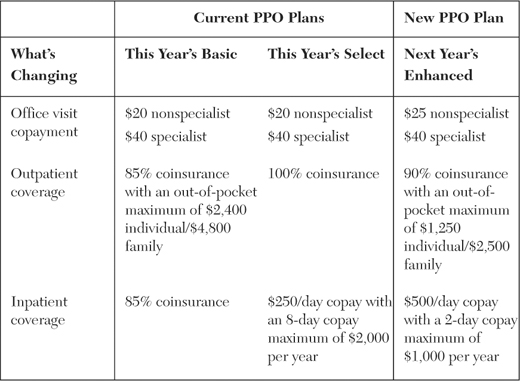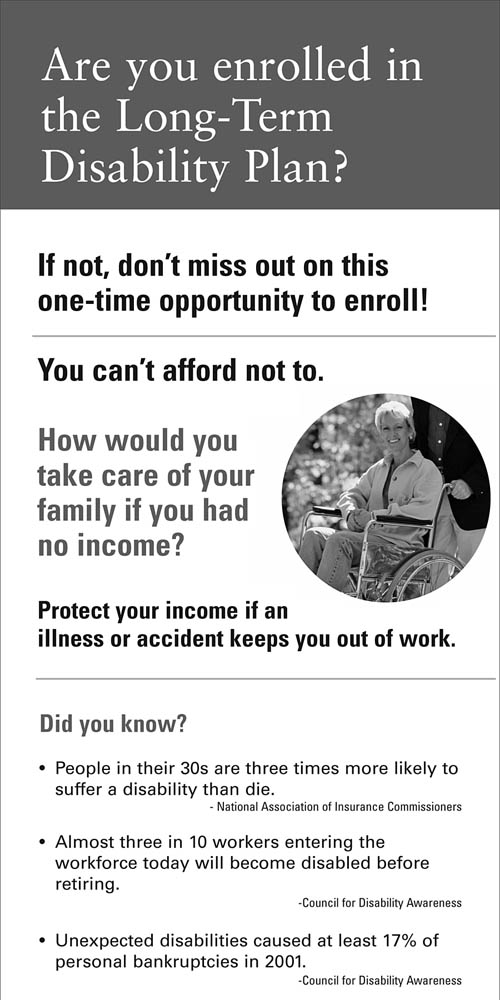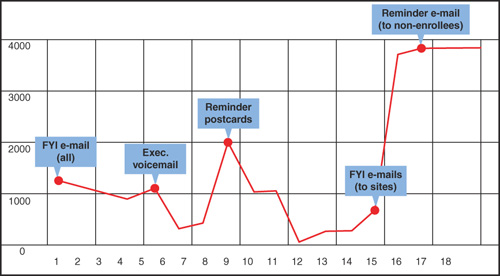13. Benefits
“My Head Hurts”
It comes around every year: benefits enrollment season. And every year you work hard to communicate benefits so that employees will understand your plan (or choice of plans) and take appropriate action.
But every year the task gets more difficult. Healthcare costs keep rising. Plan rules get more complicated. You make changes to keep costs contained, and employees view those changes as “takeaways.” And just when you think you’ve got it all under control, a big curveball (can you say “healthcare reform”?) comes along.
It’s no wonder that every year you end up with a headache that requires a jumbo bottle of extra-strength pain reliever. (Which reminds you that you need to let employees know that over-the-counter medicines can no longer be reimbursed on their flexible spending account.)
We can’t take away your headache, but we can take the pain out of communicating benefits—both during the enrollment period and throughout the year. In this chapter, we show you how.
Along the way, we give examples from a company Alison’s firm has worked with over the past several years to communicate benefits to its employees. For a variety of reasons, we can’t share the company’s real name, so we call it Walnut, Inc. Headquartered in the New York City area, Walnut has operations throughout North America with 25,000 employees in various functions, including research, manufacturing, sales, and distribution.
Is Eight Your Lucky Number?
It’s ours when it comes to benefits communication. We’ve found that following these eight steps make communicating benefits more effective:
1. Set objectives for what your company wants to achieve.
2. Understand employees’ needs and preferences.
3. Develop a planned approach.
4. Communicate simply, clearly, and candidly.
5. Manage time wisely.
6. Use tools for what they do best.
7. Focus on what employees need to do.
8. Measure progress and success.
Again, Begin with Objectives
As we said earlier, we believe that most communication projects should start with the end in mind, so you should set objectives for what you want to accomplish. (See Chapter 3, “Plan and Manage Communication,” for a lot of advice about how to do so.) This is especially true when you’re communicating benefits. Why? Because you often need employees to take actions that determine whether your benefits are successful. The idea, of course, is to make sure you design communications to support employees taking those actions.
For example, each year the benefits team at Walnut, Inc. sets objectives for desired employee behavior. Here is a sample:
• Increase participation in the long-term disability program.
• Reduce the number of calls to the HR service center (the vendor company that handles enrollment and other calls).
• Influence employees to sign up for benefits throughout the enrollment period. (The idea is to encourage them not to wait until the last two or three days to do so.)
• Encourage a percentage of employees to switch from the “preferred” PPO plan (more choices, higher premiums) to the “select” plan (fewer choices, lower premiums).
Understand What Employees Know and What They Need
Once you’re clear about what your company wants to accomplish, it’s time to turn your focus to employee needs and preferences. As we describe in Chapter 1, “Know Your Employees,” qualitative research—such as focus groups—helps you find out the following:
• How well employees understand their current benefits. Don’t assume that just because you’ve communicated the vision plan for the past five years that employees know about the importance of those benefits and how they work. You must dive deeper to get an accurate assessment.
• Perceptions about the value of benefits. Do employees appreciate what they have, or do they undervalue the program?
• What employees need to know—and how they want to receive communication.
Develop a Planned Approach
If you’ve followed steps 1 (set objectives) and 2 (find out what employees know and what they need), you have a strong basis for developing your approach to benefits communication.
Let’s use the Walnut example to explain what we mean. You’ll recall that the HR team had specific actions it wanted employees to take. And employees clearly expressed what they needed. In their own words, employees said:
• “Tell me what’s changing and what to do.”
• “Don’t sugarcoat it—give me the facts.”
• “Comparisons and examples would be helpful.”
• “Make it easy for me to make the right decision.”
Putting these together helped Walnut’s benefits director decide how to communicate to meet both HR’s objectives and employees’ needs. Here’s an excerpt from the planning tool we used to choose the right communication approach:
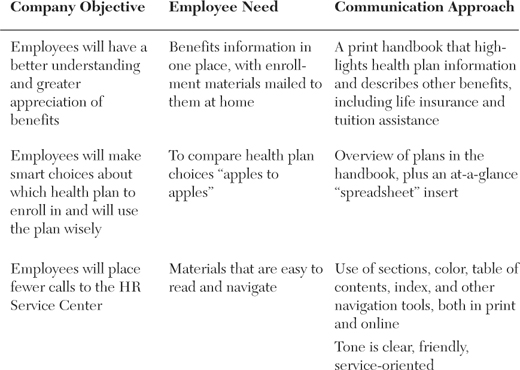
Communicate Simply, Clearly, and Candidly
We’re so passionate about being simple, clear, and candid that we could write a book about the topic—oh, right, we’re doing that here. But our advice especially applies to benefits. Because your company offers so many different benefits, and because many of them are so complex, it’s even more important that you simplify, simplify, simplify how you communicate. Here are a few tips about how to do so (some are reminders from previous chapters):
• Use the inverted pyramid to organize information. This classic structure puts the most relevant information first and saves the details for lower down in the message. And it works for any kind of communication, from e-mail to enrollment packages to benefits meetings.
• Focus on what employees need to do. In these information-overloaded times, employees want you to cut to the chase and tell them what action is required. So be clear, with content such as “Five decisions you need to make” and “A three-step process for choosing your benefits.”
• Be visual. Instead of long narrative copy, break content into easily scannable segments. For example, create a table that captures key changes to next year’s benefits. Or add a sidebar with a checklist of decision items. And whenever possible, use icons, photos, or sketches to illustrate your points.
• Avoid the urge to sugarcoat. Communicating benefits is often a “bad news, bad news” proposition. Sometimes costs increase; other times benefits are eliminated. To maintain credibility, it’s important to communicate honestly. Tell employees why a change was made, how costs were managed, and how they can choose and spend wisely.
• Don’t be shy about celebrating good things. Use communication to remind employees about benefits that are designed to make their lives better, such as flexible spending account debit cards, preventive care, discount gym memberships, and free financial advice.
• Be service-oriented. Include tips, advice, and Q&As that will help employees be smarter consumers and live healthier. Here are some examples of service-oriented topics you can integrate into your communications:
• How to determine if you’re saving enough for retirement
• Low-impact ways to get more exercise
• How I saved $300 on my prescriptions
• Five often overlooked discounts offered by the company medical plan
• Tell the “why” behind benefits changes. While you want to focus on what’s new and what employees need to do, sometimes it’s also important to remind employees why your company provides these benefits and the process you go through before making any changes. Chances are, senior leaders gave benefits changes a lot of thought, looked through the data, and made strategic decisions based on cost-benefit analysis. Walk employees through that process and present this information as a sidebar in your communication.
Give Benefits Communication a Much-Needed Voice
Here’s one more piece of advice under the category “simple, clear, and candid”: Don’t lose the human side of the equation. It’s easy to get so wrapped up in getting the facts right that you forget that communication should feel personal. After all, benefits are a topic that employees take personally. Our colleague Kimberly Gavagan recently wrote a blog for the Davis & Company website that captures this idea so well that we’d like to share it with you:
A friend of mine recently received an envelope in the mail from the life insurance provider for her company. When my friend opened it, she found generic materials sent directly from the vendor—with not even a cover letter from her own company explaining what was inside.
Her company is family-owned. Leaders make an effort to get to know employees and make them feel valued.
This generic, no-personality package was the opposite of what Sasha is used to. It contained a standard brochure and a bland form asking her to select one of two options for her life insurance coverage. There was no indication that this was part of her company’s benefits program.
Sasha was baffled. And honestly, so am I.
This strikes me as a missed opportunity. Every time you send something to your employees about benefits, you are sending two messages. The first, of course, is the information itself.
The second is silent, yet speaks volumes: It’s about creating a sense of connection between company and employee. In this case, the connection was lacking and the tone was saying, “We don’t care.”
Benefits are an emotional issue for employees. They see benefits as a way to take care of themselves and their families, provide financial security in the event of an illness or injury, and help them happily retire.
This is not the time for generic communication.
If you must use the materials your vendor supplies, at least provide employees with a little context: a cover note explaining what’s coming, why it’s important, and what employees should do.
Even better, benefits communication should align with your company’s brand. Model it after your company’s ads. Write simply, avoid jargon, and be straightforward.
The best path, of course, is to make benefits communication personal. Employees should feel like it’s coming from a human being—one who works at their company and understands them—and not a warehouse.
By doing so, you not only build understanding about benefits, but also create goodwill as well.
Manage Time Wisely
When it comes to benefits communication, the Rolling Stones got it wrong: Time is definitely not on your side. In fact, timing is one of the trickiest aspects of communicating benefits, as shown here:

We don’t have a hard-and-fast rule for managing time wisely. Instead, in each situation, we work at achieving the right balance. We seek to give employees enough time to understand an upcoming change so that they can get used to it. And we give employees a heads-up when something is coming. (“Next month is when enrollment starts.”) But we also want to be as “just in time” as possible so that employees have the information right before they need to take action. Finally, we’re big fans of “friendly reminders”—short messages that don’t overwhelm or annoy, but give employees a gentle push to get going.
The best way to manage timing, we find, is to create a timeline as part of your communication plan (see Chapter 3). That way, you can map out how employees will learn about benefits and ensure that the timing creates understanding and encourages people to take action. Figure 13-1 shows what we mean.
Figure 13-1 Communication timeline
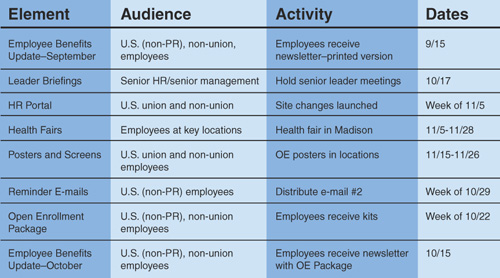
More Examples: “Here’s a Preview” and “Don’t Forget”
Our friends at Walnut think a lot about timing. One technique that’s worked well is to provide a heads-up about upcoming benefit changes about a month before open enrollment begins:
Preview of Benefit Changes for Next Year
Many employees have said it is helpful to learn about changes in advance of Open Enrollment. While you’ll find details of next year’s benefit changes in your Open Enrollment packet in early October, here’s a preview of what’s changing.
For next year, Walnut has made changes that keep projected healthcare cost increases under control and also has added plan features that can save you money and time. This includes important changes to the medical plans, Health Care Spending Account, and voluntary life insurance. Read on to learn more.
Once enrollment begins, Walnut sends e-mail, displays posters, and mails postcards designed to provide gentle reminders to employees. For example, here’s a personalized e-mail sent only to employees who have not yet enrolled:
Don’t wait until the last day to enroll!
Our records show that you have not yet made your benefit elections for next year. If you are not currently enrolled in Long-Term Disability coverage, don’t miss out on this one-time opportunity to join the plan without submitting evidence of good health.
Also, you must enroll in the Health Care and/or Dependent Care Flexible Spending Accounts if you want to participate in these accounts next year.
The deadline for enrolling in all these plans is November 29.
Enroll online by visiting www.mybenefits.com.
Enroll by phone by calling 800-XXX-XXXX.
If this is your first time enrolling online, at the Login screen, enter your social security number in the “user name” field and the last four digits of your employee ID number in the “PIN” field.
Questions? Call the HR Service Center at 800-XXX-XXXX.
The result of making an investment in timing? Walnut has been able to achieve one of its main objectives: persuade employees to act throughout enrollment, and not wait until the last minute to sign up. (This saves the company money by not incurring extra vendor charges and also reduces errors.) For instance, by giving employees information in advance during one year’s open enrollment, Walnut persuaded them to sign up early:
This Year’s Daily Enrollment Was More Balanced Than Last Year’s

Use Tools for What They Do Best
We talk a lot about tools in Chapter 7, “Use the Right Tool for the Job,” so we’ll be brief here. In fact, we can boil down our advice to one sentence: When it comes to benefits communication, don’t use e-mail for everything.
E-mail is great for timely reminders. And for quick checklists. And to provide handy links to information available on a website.
But e-mail is not as effective as other communication channels for conveying complex information. For instance, we love web tools that help employees enter personalized data and calculate the best choices for them. And we love posters and postcards for providing important information at a glance.
However, we must confess that our favorite tool for communicating benefits is still, after all these years, a print publication. Whether it’s a brief flyer (such as a “Slim Jim” that fits into a #10 standard envelope), a four-page newsletter, or a full brochure, we find that print fits the bill for the following:
• Compiling all the facts that employees need to understand benefits and make decisions
• Including charts, tables, and other ways to compare information
• Bringing benefits to life through examples
• Allowing employees to share information with significant others
Emphasize Action
One thing we like about benefits communication is that it’s action-packed. Seriously. The reason to communicate is not simply to provide information; it’s to give employees what they need to do something (and that something usually helps them). So we plan and create our communication keeping desired action steps in mind. We use words and phrases such as these:
• What you need to do
• Reminder
• How to
• Don’t miss out
Measure Twice; Cut Once
As we describe in Chapter 9, “Measure Effectiveness,” measuring your communication is essential for testing its impact, to demonstrate its value, and also to adjust and improve your communications going forward. You can measure benefits communication in a variety of ways, including spot surveys during and after enrollment, an annual (or biannual) survey, and detailed reporting from your database or vendor systems.
Wondering which questions to ask? Here are a few standard survey questions:
The enrollment package mailed to my home was useful.
Strongly agree Agree Disagree Strongly disagree
I understood the choices available to me.
Strongly agree Agree Disagree Strongly disagree
I felt prepared to make smart decisions about enrollment.
Strongly agree Agree Disagree Strongly disagree
Checklist for Helping Employees Understand Their Benefits So That They Know What to Do
![]() Know what you want to accomplish.
Know what you want to accomplish.
![]() Ask employees what they know and need.
Ask employees what they know and need.
![]() Make even the most complicated benefits information simple.
Make even the most complicated benefits information simple.
![]() Keep an eye on the calendar to get the timing right.
Keep an eye on the calendar to get the timing right.
![]() Don’t rely only on e-mail; take out the other tools in your communication toolbox.
Don’t rely only on e-mail; take out the other tools in your communication toolbox.
![]() Emphasize steps employees need to take, and encourage them to act now.
Emphasize steps employees need to take, and encourage them to act now.
![]() Measure to demonstrate success and get ready for next time.
Measure to demonstrate success and get ready for next time.

